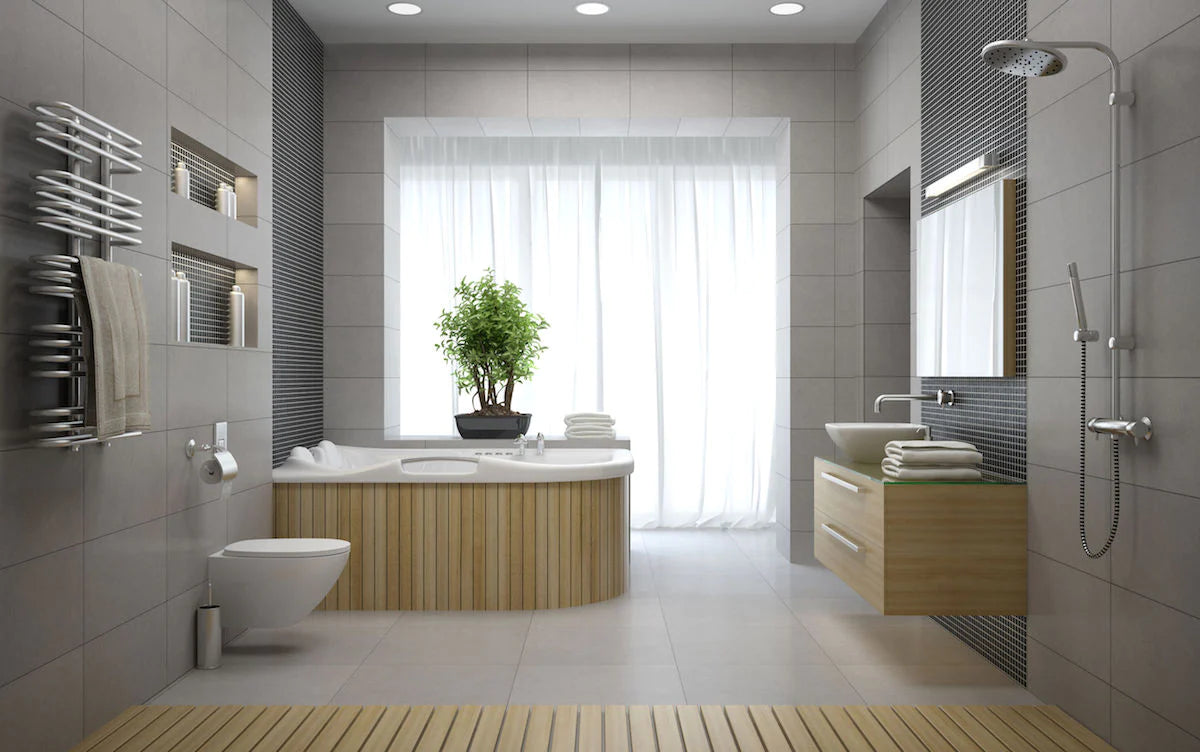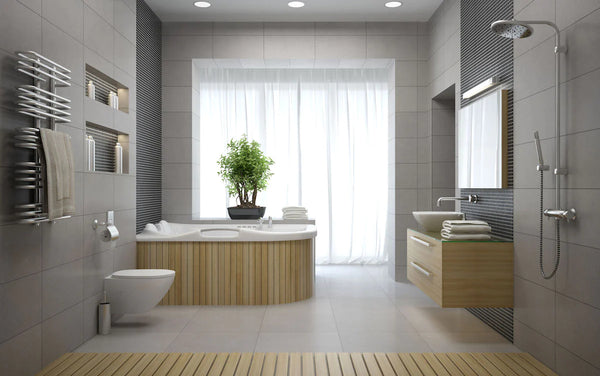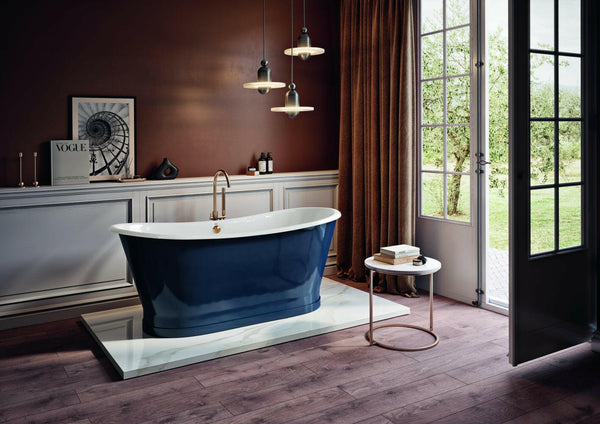Stone is an important element in our physical world and many homeowners and designers enjoy using it in the bathroom to create a soothing and natural feel. With so many options for stone floors, walls and showers, it might feel overwhelming trying to narrow down your choices. If you’re ready to join the trend, follow these expert tips for incorporating stone into the bathroom.
Considerations When Choosing Natural Stone
Stone is a durable and popular material that helps homeowners create a unique look in their bathroom.
Natural stone is less common than engineered stone and can be more expensive. This is because each natural stone slab undergoes a detailed mining, cutting and polishing process, home renovation writer Lee Wallender explains. Using natural stone means that your bathroom will be completely unique. In addition, “using marble or other natural stone in your home almost automatically improves its resale value,” Wallender says.
This is different from engineered stone, which tends to have a more uniform look. Engineered stone primarily uses quartz as its base, according to the experts at Townsville Stone. This makes the buying process a bit different as well, because you can choose the specific slab you’d like to use in your bathroom. With natural stone, you can select a general color and style, but the piece you actually get will likely look different from the one you chose in store.
Still, there are a few practical considerations homeowners should keep in mind. Here’s what to know before you jump into a design decision involving stone.
Stone Flooring
Polished stone floors can be slippery when wet. Stone flooring with a textured surface is more skid-resistant, residential builder John Riha writes. He adds that tumbled varieties are best. Although they have been mechanically sanded down to eliminate rough edges and soft spots, tumbled stone retains its natural textures and has good slip resistance.
Maintenance is another factor to consider. Stone needs to be cleaned and dried often in order to avoid water spots. Some natural stone, like travertine, has large pores, Sefa Stone explains. This makes it easier for dirt, liquid and grime to accumulate into the pores of the stone and tarnish its appearance.
Adding a sealant and spot cleaning the floor often can help prevent such damage. Moreover, avoiding harsh cleaning products can keep your stone looking good longer, writes Stephanie Vozza at Dwyer Marble & Stone. Instead, choose a gentle cleanser and use a soft cloth.
Aside from safety and cleanliness, homeowners should think about comfort when installing stone flooring into a bathroom. Stone floors can be significantly colder than wood or vinyl floors, especially in early morning or during winter months. Older people and young children might find this particularly uncomfortable when using the bathroom. Fortunately, installing a heated floor is an easy way to counter the cold, Atlas Marble and Tile notes. Stone tiles are sensitive to temperature and therefore can heat up or cool down quickly.

Stone Countertops
Stone is a beautiful option for bathroom countertops as well. You might decide to contrast a countertop stone against flooring stone to create visual interest. This is especially true if you’re not sure about covering your entire floor with marble, but still want to incorporate it into your bathroom, stone exporter Marmol explains. A marble countertop and slate floor, for example, provide a nice contrast, and it’s good to remember that countertops don’t require as much maintenance as stone floors.
Quartz is the second most popular bathroom countertop option after marble, and its usually more affordable.
“Quartz is made from 90 percent or more natural stone and the rest petroleum-based resin. It is stronger than granite and seldom develops scratches or stains, but can if mistreated,” writes Elisabeth Leamy, Washington Post columnist. Many people prefer quartz because it comes in a wide variety of colors and doesn’t need to be sealed. Moreover, certain slabs of quartz look very similar to marble, so you can achieve a high-class look without the additional maintenance.
Quartzite is another common option for the bathroom. Quartzite is particularly popular because it has a elegant, fine-grained look that coincides with modern, Scandinavian and minimalist styles. Plus, with quartzite, homeowners can be sure that their countertop won’t scratch or stain easily.
While quartzite is scratch and acid resistant, however, Terrazzo & Marble Supply Companies explain that the overall durability of quartzite depends on the hardness of the slab. This is because different hardness levels require different protectants and sealants, and the proper treatment can ensure a long-lasting countertop.
For something less flashy than quartzite, soapstone and sandstone create a natural and soothing look. Stone installation expert G.M.S. Wërks adds that sandstone varies by color depending on which minerals were involved in its formation. Iron, for example, gives a reddish color that can work well in bathrooms with a desert or forest theme.
Soapstone, on the other hand, tends to be softer and grayer in color. It is extremely dense and not porous, meaning it’s easy to maintain as a countertop. Plus, it can be sealed with just a coat of mineral oil, which in turn brings out a richer color.

Stone Showers and Walls
Stone can make a classy, comfortable shower when used and cared for properly. The most popular stones for the shower are marble and granite, mainly because they look nice and are easy to care for. Onyx, sandstone and travertine also make great options for showers, according to stone care products company Granite Gold. Onyx offers a sleek and polished look, while sandstone creates a more earthy aesthetic.
When seeking a durable and earthy look in the master bathroom, consider slate tile for the shower walls. Natural stone experts CUPA Stone show how slate can be used to create a look of uniformity in the bathroom. Since it’s water-resistant, slate can be used both on the walls of the shower and on the walls throughout the bathroom to maintain a consistent aesthetic. Both stone slabs and small stone tiles work well in this situation.
Stone can be used to make a statement in luxurious bathrooms. Adorning an entire bathroom in marble might not be practical or easy to maintain; however, an accent wall is a great way to add marble to a bathroom, writes the team at Surrey Marble and Granite. Specifically, marble can be added as an accent along the countertop backsplash or as a border around the shower or tub. Granite and limestone are also strong choices for homeowners seeking a more nature-inspired look.
Depending on how the rest of your bathroom is decorated, an accent wall can anchor in a spa-like look and unite other stone and natural elements incorporated strategically into the space.
Images by: Dmitry Koksharov/©123RF.com, Digital Buggu, Aleksei Potov/©123RF.com






